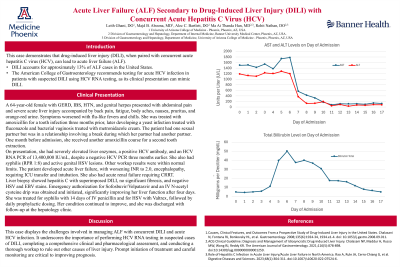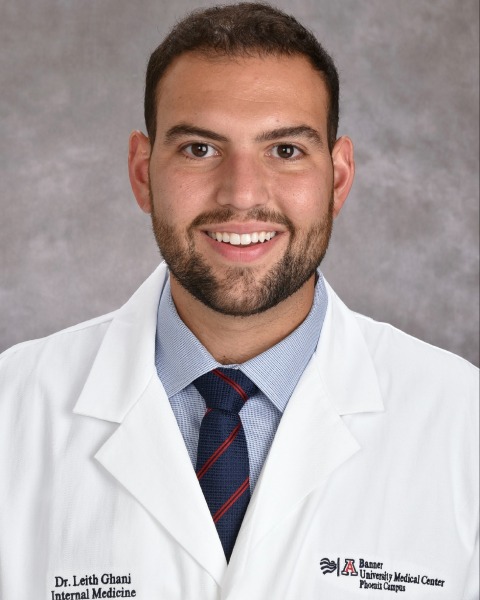Sunday Poster Session
Category: Liver
P1293 - ALF Secondary to DILI With Concurrent Acute HCV
Sunday, October 27, 2024
3:30 PM - 7:00 PM ET
Location: Exhibit Hall E

Has Audio

Leith Ghani, DO
Banner University Medical Center
Paradise Valley, AZ
Presenting Author(s)
Leith Ghani, DO1, Majd B. Aboona, MD2, Alec C. Bartlett, DO3, Ma Ai Thanda Han, MD2, Rohit Nathan, DO2
1Banner University Medical Center, Phoenix, AZ; 2University of Arizona College of Medicine, Phoenix, AZ; 3Banner University, Phoenix, AZ
Introduction: This case demonstrates that drug-induced liver injury (DILI) when paired with concurrent acute hepatitis C virus (HCV) can lead to acute liver failure (ALF). DILI accounts for approximately 13% of ALF cases in the United States. The American College of Gastroenterology recommends testing for acute HCV infection in patients with suspected DILI using HCV RNA testing, as its clinical presentation can mimic DILI.
Case Description/Methods: A 64-year-old female with past medical history of GERD, IBS, HTN, and genital herpes presented with abdominal pain and severe acute liver injury, accompanied by back pain, fatigue, body aches, nausea, pruritus, and orange-red urine. Symptoms worsened with flu-like symptoms of fevers and chills, starting three months prior after amoxicillin treatment for a tooth infection. She later developed a yeast infection treated with fluconazole and bacterial vaginosis treated with metronidazole cream. The patient had one sexual partner, with a break during which her partner had another partner. One month before admission, she received another amoxicillin course for a second tooth extraction.
On presentation, she had severely elevated liver enzymes, a positive HCV antibody, and an HCV RNA PCR of 13,400,000 IU/mL, despite a negative HCV PCR three months earlier. She also had syphilis (RPR 1:8) and active genital HSV lesions. Other workup results were within normal limits. The patient developed acute liver failure, with worsening INR to 2.0, encephalopathy, and required ICU transfer and intubation. She also had acute renal failure requiring CRRT.
Liver biopsy showed hepatitis C with superimposed DILI, no significant fibrosis, and negative HSV and EBV stains. Emergency authorization for Sofosbuvir/Velpatasvir and an IV N-acetyl cysteine drip was obtained and initiated, significantly improving liver function after four days. She was treated for syphilis with 14 days of IV penicillin and for HSV with Valtrex, followed by daily prophylactic dosing. She continued to improve and was discharged with follow-up at the hepatology clinic.
Discussion: This case emphasizes the challenges involved in managing ALF with concurrent DILI and acute HCV infection. It underscores the importance of performing HCV RNA testing in suspected cases of DILI, conducting a comprehensive clinical and pharmacological assessment, and conducting a thorough workup to rule out other causes of liver injury. Prompt initiation of treatment and careful monitoring are crucial in improving the prognosis.
Note: The table for this abstract can be viewed in the ePoster Gallery section of the ACG 2024 ePoster Site or in The American Journal of Gastroenterology's abstract supplement issue, both of which will be available starting October 27, 2024.
Disclosures:
Leith Ghani, DO1, Majd B. Aboona, MD2, Alec C. Bartlett, DO3, Ma Ai Thanda Han, MD2, Rohit Nathan, DO2. P1293 - ALF Secondary to DILI With Concurrent Acute HCV, ACG 2024 Annual Scientific Meeting Abstracts. Philadelphia, PA: American College of Gastroenterology.
1Banner University Medical Center, Phoenix, AZ; 2University of Arizona College of Medicine, Phoenix, AZ; 3Banner University, Phoenix, AZ
Introduction: This case demonstrates that drug-induced liver injury (DILI) when paired with concurrent acute hepatitis C virus (HCV) can lead to acute liver failure (ALF). DILI accounts for approximately 13% of ALF cases in the United States. The American College of Gastroenterology recommends testing for acute HCV infection in patients with suspected DILI using HCV RNA testing, as its clinical presentation can mimic DILI.
Case Description/Methods: A 64-year-old female with past medical history of GERD, IBS, HTN, and genital herpes presented with abdominal pain and severe acute liver injury, accompanied by back pain, fatigue, body aches, nausea, pruritus, and orange-red urine. Symptoms worsened with flu-like symptoms of fevers and chills, starting three months prior after amoxicillin treatment for a tooth infection. She later developed a yeast infection treated with fluconazole and bacterial vaginosis treated with metronidazole cream. The patient had one sexual partner, with a break during which her partner had another partner. One month before admission, she received another amoxicillin course for a second tooth extraction.
On presentation, she had severely elevated liver enzymes, a positive HCV antibody, and an HCV RNA PCR of 13,400,000 IU/mL, despite a negative HCV PCR three months earlier. She also had syphilis (RPR 1:8) and active genital HSV lesions. Other workup results were within normal limits. The patient developed acute liver failure, with worsening INR to 2.0, encephalopathy, and required ICU transfer and intubation. She also had acute renal failure requiring CRRT.
Liver biopsy showed hepatitis C with superimposed DILI, no significant fibrosis, and negative HSV and EBV stains. Emergency authorization for Sofosbuvir/Velpatasvir and an IV N-acetyl cysteine drip was obtained and initiated, significantly improving liver function after four days. She was treated for syphilis with 14 days of IV penicillin and for HSV with Valtrex, followed by daily prophylactic dosing. She continued to improve and was discharged with follow-up at the hepatology clinic.
Discussion: This case emphasizes the challenges involved in managing ALF with concurrent DILI and acute HCV infection. It underscores the importance of performing HCV RNA testing in suspected cases of DILI, conducting a comprehensive clinical and pharmacological assessment, and conducting a thorough workup to rule out other causes of liver injury. Prompt initiation of treatment and careful monitoring are crucial in improving the prognosis.
Note: The table for this abstract can be viewed in the ePoster Gallery section of the ACG 2024 ePoster Site or in The American Journal of Gastroenterology's abstract supplement issue, both of which will be available starting October 27, 2024.
Disclosures:
Leith Ghani indicated no relevant financial relationships.
Majd Aboona indicated no relevant financial relationships.
Alec Bartlett indicated no relevant financial relationships.
Ma Ai Thanda Han indicated no relevant financial relationships.
Rohit Nathan indicated no relevant financial relationships.
Leith Ghani, DO1, Majd B. Aboona, MD2, Alec C. Bartlett, DO3, Ma Ai Thanda Han, MD2, Rohit Nathan, DO2. P1293 - ALF Secondary to DILI With Concurrent Acute HCV, ACG 2024 Annual Scientific Meeting Abstracts. Philadelphia, PA: American College of Gastroenterology.
